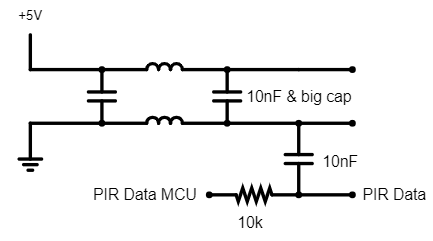Motion Sensor triggering on its own
-
Did you guys get them working? I tried to power the pir sensor via the "H" pad directly with 3.3V from a boost converter (via a coin cell). Now I get random readings that I didn't have when using a stable 3.3V source. Any ideas how to solve this?
I haven't (yet) removed the voltage regulator on board. Perhaps that might help... -
Hi,
False detection is only due to power stability issue.
Personnaly i remove the regulator and power the PIR without any boost on the VCC pin. Even below 2v the PIR continue working without any a single issue.Did you try to do a small delay before sleeping with interupt ? See my post a bit upper.
For me it solve all my false trigger issue.
-
I know this thread's about hc-501. But I guess one can apply some of my hc-505 (mini-pir) experiences from here:
https://forum.mysensors.org/topic/2715/slim-node-as-a-mini-2aa-battery-pir-motion-sensor -
Same problem here every time m node wake-up I have a false trigger. With delay (@fifipil909) it's not better
-
Mhm I still have strange results from my PIR sensor (doesn't even seem to be the wake up that influences them).
I have the pir with diode and voltage regulator removed powered by a boost converter with the low pass filter and a pull down resistor. Using a clean 3.3V worked though, but I really want to use batteries (with sometimes less than 3V). Directly powering the sensor with the 2.x V did not work either.
For one of the guys with working sensors: what is your exact setup? None of the tipps I found seem to work. I would really love to get one sensor running. Only idea I still have is to try with another sensor.Here is the code I am currently using:
#include <MySensor.h> #include <SPI.h> unsigned long SLEEP_TIME = 120000; // Sleep time between reports (in milliseconds) #define DIGITAL_INPUT_SENSOR 3 // The digital input you attached your motion sensor. (Only 2 and 3 generates interrupt!) #define INTERRUPT DIGITAL_INPUT_SENSOR-2 // Usually the interrupt = pin -2 (on uno/nano anyway) #define CHILD_ID 1 // Id of the sensor child #ifdef DEBUG #define DEBUG_SERIAL(x) Serial.begin(x) #define DEBUG_PRINT(x) Serial.print(x) #define DEBUG_PRINTLN(x) Serial.println(x) #else #define DEBUG_SERIAL(x) #define DEBUG_PRINT(x) #define DEBUG_PRINTLN(x) #endif MySensor gw; // Initialize motion message MyMessage msg(CHILD_ID, V_TRIPPED); void setup() { DEBUG_SERIAL(9600); // <<<<<<<<<<<<<<<<<<<<<<<<<< Note BAUD_RATE in MySensors.h DEBUG_PRINTLN("Serial started"); gw.begin(); // Send the sketch version information to the gateway and Controller gw.sendSketchInfo("Motion Sensor Test", "24052016"); pinMode(DIGITAL_INPUT_SENSOR, INPUT); // sets the motion sensor digital pin as input // Register all sensors to gw (they will be created as child devices) gw.present(CHILD_ID, S_MOTION); } void loop() { // Read digital motion value boolean tripped = digitalRead(DIGITAL_INPUT_SENSOR) == HIGH; DEBUG_PRINT("Got tripped: "); DEBUG_PRINTLN(tripped); gw.send(msg.set(tripped?"1":"0")); // Send tripped value to gw DEBUG_PRINTLN("Sleeping till next interrupt"); // Sleep until interrupt comes in on motion sensor. Send update every two minute. //gw.sleep(INTERRUPT,CHANGE, SLEEP_TIME); // Sleep until interrupt comes in on motion sensor. Won't wake up otherwise gw.sleep(500); gw.sleep(INTERRUPT, CHANGE, 0); //gw.sleep(INTERRUPT, RISING, 0); } -
Does anyone have an idea how to get the pir sensor running with a coin cell? Or perhaps if that doesn't work with 2 aa's? See my post above
-
Sorry for necroposting on my first forum post but I have the exact same issue at the moment. I power PIR sensors from the same 3.3V switching regulator that powers an esp12 module. I took off the anti-inversion diode and the linear regulator, added a 470uF and 100nF capacitor on the sensor supply input. This has been done to two sensors, one is working flawlessly the other one has a false trigger once every half an hour.
Adding HF and LF bypass capacitors with some improvement told me that was a supply instability issue but it's not solving the problem completely. My suspect is that the polarity inversion diode that I took off had a role in the play improving the supply voltage stability.....I'll try to put back the diode and I'll let you know.cheers
Luca -
This is an issue i've been fighting for awhile as well. In industry, i've encountered PIR modules / old sensors can be susceptible to high freq interference. E.g. I have WiFi on my PI.
-
Ensure the PIR is a 6in+ physical distance from your dev board / any radios. This helps.
-
Ensure no high freq noise can couple on any of the 3 wires connected to the PIR

I did #2 via a PI filter. Inductors + a cap. Ideally i'd have caps at both ends of high and low values for both frequency contents. The signal line itself can couple noise so ideally a ferrite bead + resistor to snub any type of noise. I've had to employ similar strategies with other sensors to deal w/ interference issues.
-
-
Have this same issue and it makes me crazy... I use a step up converter DCDC 1.8V up to 3.3 input and output 3.3V. If solder from DCDC Out via 220uF direct soldered after stabilizer of HC501 direct on pcb and sometimes it will detect motion where no motion happens. I use two AA accu and i know that they have together 2,4V. Less voltage less current. But i try also with normal AA 3V then i have this issue not so often. But i have. It will much more if the voltage will more less.
